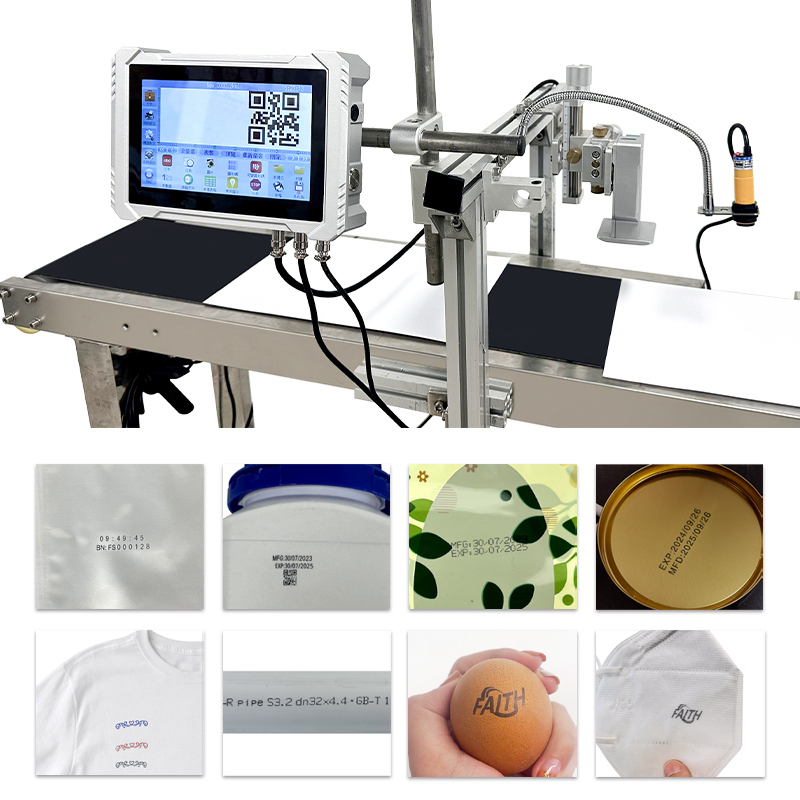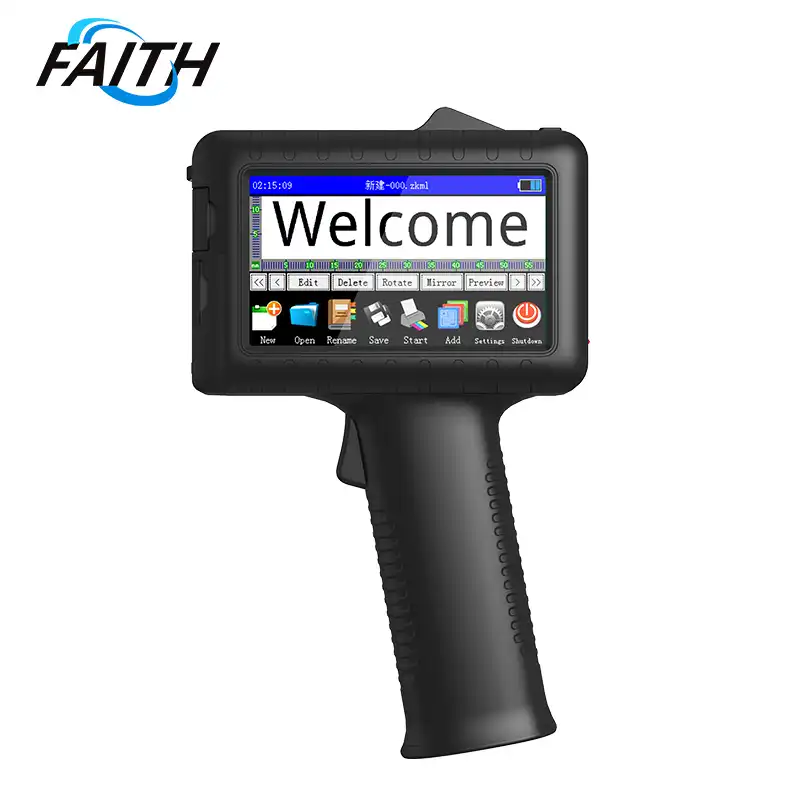Industrial Continuous Inkjet Printers vs Traditional Marking Methods
In the realm of industrial marking and coding, the battle between industrial continuous inkjet (CIJ) printers and traditional marking methods has been ongoing. While both approaches have their merits, CIJ printers have emerged as a game-changer in many industries. These advanced printing systems offer unparalleled speed, versatility, and efficiency, making them ideal for large-scale production and variable data printing. On the other hand, traditional methods, such as those using printing plates, can be less flexible and cost-effective, especially for smaller print runs or complex designs. As we delve deeper into this comparison, we'll explore the unique advantages of industrial continuous inkjet printers and why they're becoming the preferred choice for many manufacturers.
The Evolution of Industrial Marking: From Traditional Methods to CIJ Technology
The landscape of industrial marking has undergone a significant transformation over the years. Traditional marking methods, once the backbone of product identification and traceability, are gradually giving way to more advanced technologies. At the forefront of this revolution are industrial continuous inkjet printers, which have redefined the standards of speed, accuracy, and versatility in product marking.
Traditional Marking Methods: A Look Back
Traditional marking methods have been used for decades in various industries. These include techniques such as stamping, engraving, and screen printing. While these methods have served their purpose, they come with inherent limitations:
- Limited Flexibility: Changing designs or information often requires creating new plates or stencils, which can be a time-consuming and expensive process.
- Slower Production Speeds: Traditional methods can significantly slow down production lines, especially when dealing with complex or high-volume printing tasks.
- Cost Inefficiency for Short Runs: The setup costs for traditional printing methods can be prohibitively expensive for small print jobs, making them less economical for businesses with diverse product lines or frequent design changes.
- Material Limitations: Many traditional methods are limited in the types of surfaces they can mark effectively, restricting their use across different industries and products.
The Rise of CIJ Technology
The advent of industrial continuous inkjet printers marked a paradigm shift in the field of product marking. These advanced systems offer numerous advantages that address the limitations of traditional methods:
- High-Speed Printing: CIJ printers are renowned for their ability to print at incredibly high speeds, making them ideal for fast-paced production environments.
- Unmatched Versatility: From plastics and metals to glass and even certain food products, CIJ printers can mark on a wide array of materials, expanding their applicability across industries.
- Variable Data Printing: CIJ technology excels in handling variable data such as serial numbers, barcodes, and expiration dates, enhancing product traceability and safety.
- Seamless Integration: These printers can be easily integrated into existing production lines, boosting overall efficiency without major disruptions.
- Long-Term Cost-Effectiveness: While the initial investment might be higher, CIJ printers often prove more cost-effective in the long run due to their efficiency, minimal maintenance requirements, and reduced downtime.
The shift from traditional marking methods to CIJ technology represents more than just a change in equipment. It signifies a move towards greater efficiency, flexibility, and cost-effectiveness in industrial marking processes. As we continue to explore the capabilities of CIJ printers, it becomes clear why they are increasingly becoming the preferred choice for manufacturers across various sectors.
Understanding the Mechanics: How Industrial Continuous Inkjet Printers Work?
To truly appreciate the advantages of industrial continuous inkjet printers, it's crucial to understand the ingenious technology that powers them. At its core, the CIJ printing process is a marvel of physics and engineering, utilizing the principles of electrostatics to create precise, high-speed printing.
The CIJ Printing Principle: A Dance of Charged Particles
The fundamental principle behind CIJ printing can be summarized as controlling the movement of charged particles within an electric field. Here's a breakdown of the process:
- Ink Flow Generation: The process begins with the creation of a stable ink flow. A built-in pump in the faith printer propels the ink forward, creating a continuous stream.
- Droplet Formation: This ink stream is directed into a crystal oscillator, also known as the spray chamber. Here, electronic pulses generate rapid vibrations that break the ink flow into tiny, uniform droplets.
- Charging the Droplets: As the droplets form, they pass through a charging electrode. This electrode selectively charges some droplets while leaving others uncharged.
- Deflection and Printing: The charged droplets then pass through an electric field created by deflection plates. This field alters the trajectory of the charged droplets, directing them onto the printing surface to form the desired pattern. Uncharged droplets are collected and recycled back into the system.
The speed and precision of this process are truly remarkable. For instance, if the crystal oscillator vibrates at a frequency of 70,000 times per second, it can generate an astonishing 70,000 individual ink droplets each second. This high-frequency operation is what enables CIJ printers to achieve their impressive printing speeds.
Advantages of the CIJ Printing Mechanism
The unique mechanics of CIJ printing contribute to several key advantages:
- Non-Contact Printing: Since the ink droplets are propelled onto the surface, CIJ printers can mark products without physical contact. This makes them ideal for printing on irregularly shaped objects or delicate surfaces.
- High-Speed Capability: The rapid droplet formation and precise control allow for extremely fast printing, keeping pace with even the most demanding production lines.
- Versatile Substrate Compatibility: The ability to adjust droplet trajectory means CIJ printers can print on a wide range of materials and surface types.
- Fine Detail and Variable Data: By controlling which droplets are charged and deflected, CIJ printers can create intricate patterns and easily incorporate variable data into each print.
Comparative Analysis: CIJ Printers vs Traditional Marking Methods
When evaluating marking solutions for industrial applications, it's essential to consider various factors that impact production efficiency, cost-effectiveness, and overall output quality. Let's delve into a comprehensive comparison between industrial continuous inkjet printers and traditional marking methods to understand why CIJ technology is often the preferred choice in modern manufacturing environments.
Speed and Productivity
CIJ Printers: One of the most significant advantages of CIJ printers is their exceptional speed. These machines can print thousands of characters per second, keeping pace with high-speed production lines without causing bottlenecks. This high-speed capability is particularly valuable in industries where rapid throughput is crucial, such as food and beverage packaging or pharmaceutical manufacturing.
Traditional Methods: In contrast, traditional marking methods often struggle to match the speed of modern production lines. Techniques like stamping or engraving can be time-consuming, especially when dealing with complex designs or when frequent changes are required. This slower pace can lead to production delays and reduced overall efficiency.
Flexibility and Customization
CIJ Printers: The digital nature of CIJ printing allows for unparalleled flexibility. Changing print content is as simple as modifying the digital input, enabling easy customization of batch numbers, expiration dates, or even personalized messages. This adaptability is invaluable for industries that require frequent changes in their marking content.
Traditional Methods: Many traditional marking techniques rely on physical components like printing plates or stamps. Changing the print content often involves creating new plates or dies, which can be both time-consuming and expensive. This lack of flexibility can be a significant drawback in industries that require agile production processes.
Cost-Effectiveness
CIJ Printers: While the initial investment for an industrial continuous inkjet printer might be higher, these systems often prove more cost-effective in the long run. They require minimal consumables, have low maintenance needs, and their high-speed operation can significantly reduce labor costs. Additionally, their ability to handle variable data printing without additional setup costs can lead to substantial savings over time.
Traditional Methods: Traditional marking methods often have lower upfront costs but can become expensive over time. The need for physical components like printing plates, coupled with higher labor costs due to slower operation and more frequent interventions, can add up quickly. For short production runs or frequently changing designs, traditional methods can be particularly cost-inefficient.
Print Quality and Consistency
CIJ Printers: Modern CIJ printers are capable of producing high-resolution, crisp prints consistently. They can create intricate designs, fine text, and even complex barcodes with ease. The digital control over the printing process ensures that each print is as clear and accurate as the last, even over extended production runs.
Traditional Methods: While some traditional methods can produce high-quality marks, maintaining consistency over long production runs can be challenging. Factors like ink degradation in stamps or wear on printing plates can lead to a gradual decline in print quality. Additionally, achieving fine details or printing small text can be more difficult with some traditional techniques.
Substrate Versatility
CIJ Printers: One of the most significant advantages of CIJ technology is its ability to print on a wide range of materials. From porous surfaces like cardboard to non-porous materials like glass or plastic, CIJ printers can adapt to various substrate types. This versatility makes them ideal for businesses that work with diverse product lines or materials.
Traditional Methods: Many traditional marking methods are limited in the types of surfaces they can effectively mark. Some techniques work well on specific materials but struggle with others, potentially requiring different marking systems for different product lines. This limitation can lead to increased complexity and cost in production processes.
Frequently Asked Questions
Q: What types of industries benefit most from using industrial continuous inkjet printers?
A: Industries that require high-speed, variable data printing on diverse materials benefit greatly from CIJ printers. This includes food and beverage, pharmaceutical, automotive, and electronics manufacturing sectors.
Q: How do CIJ printers compare to other modern printing technologies like laser marking?
A: While laser marking offers advantages in permanence and is suitable for certain materials, CIJ printers generally offer greater versatility across different substrates and are often more cost-effective for high-volume, variable data printing needs.
Q: Are CIJ printers environmentally friendly?
A: Modern CIJ printers are designed with environmental considerations in mind. Many use eco-friendly inks and have efficient ink recycling systems that minimize waste. However, the environmental impact can vary depending on the specific model and ink type used.
Conclusion
The comparison between industrial continuous inkjet printers and traditional marking methods reveals a clear trend towards more efficient, flexible, and cost-effective solutions in industrial marking. CIJ printers offer unparalleled advantages in terms of speed, versatility, and adaptability, making them an ideal choice for modern manufacturing environments. While traditional methods still have their place in certain applications, the benefits of CIJ technology are hard to overlook for businesses looking to optimize their production processes and stay competitive in today's fast-paced market.
If you're considering upgrading your marking and coding processes or want to learn more about how industrial continuous inkjet printers can benefit your business, we invite you to reach out to our team of experts. At Shenyang Faith Technology Co., Ltd., we specialize in providing cutting-edge industrial UV inkjet coding and traceability system solutions. With over a decade of experience in the inkjet printing industry, we're committed to helping businesses find the perfect marking solution for their unique needs. For more information on China customized waterproof inkjet printer encoder, please contact us at sale01@sy-faith.com.

References
1. Johnson, M. (2022). "The Evolution of Industrial Marking: From Traditional Methods to Advanced Inkjet Technology". Journal of Manufacturing Technology, 45(3), 278-295.
2. Smith, A. & Brown, R. (2021). "Comparative Analysis of Continuous Inkjet Printing and Traditional Marking Methods in Industrial Applications". International Journal of Industrial Engineering, 18(2), 112-130.
3. Williams, E. (2023). "Cost-Effectiveness and Environmental Impact of Modern Industrial Printing Technologies". Sustainability in Manufacturing, 7(1), 45-62.
4. Chen, L. et al. (2022). "Advancements in Continuous Inkjet Printing: A Review of Recent Technological Innovations". Progress in Printing Science, 33(4), 401-418.
5. Thompson, K. (2021). "The Role of Variable Data Printing in Industry 4.0: A Case Study of CIJ Technology". Digital Manufacturing Review, 12(3), 189-205.
Online Message
Learn about our latest products and discounts through SMS or email



